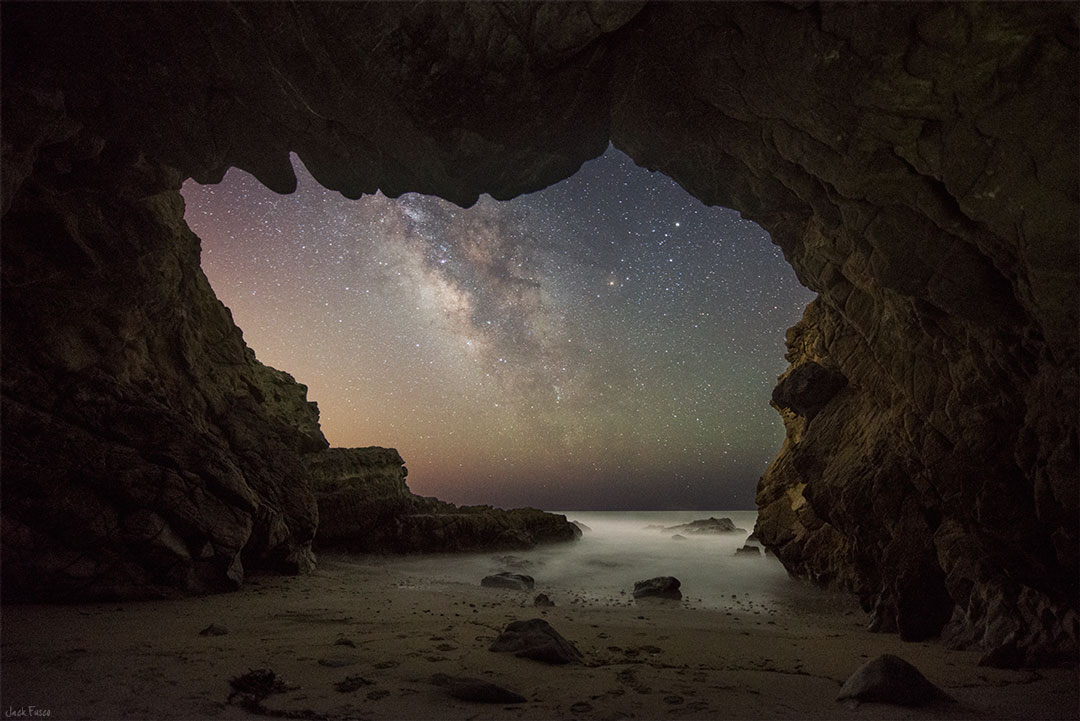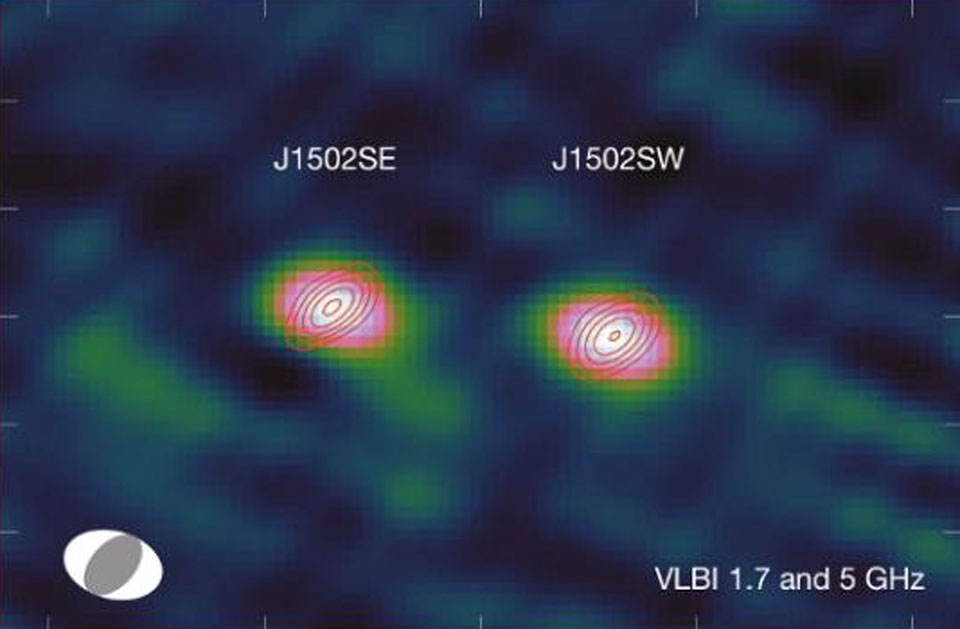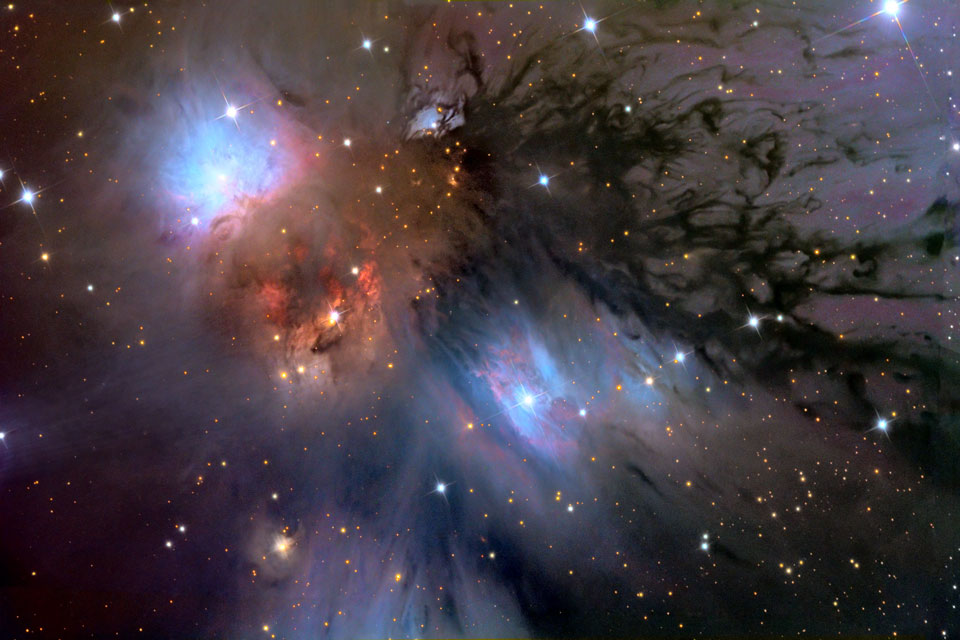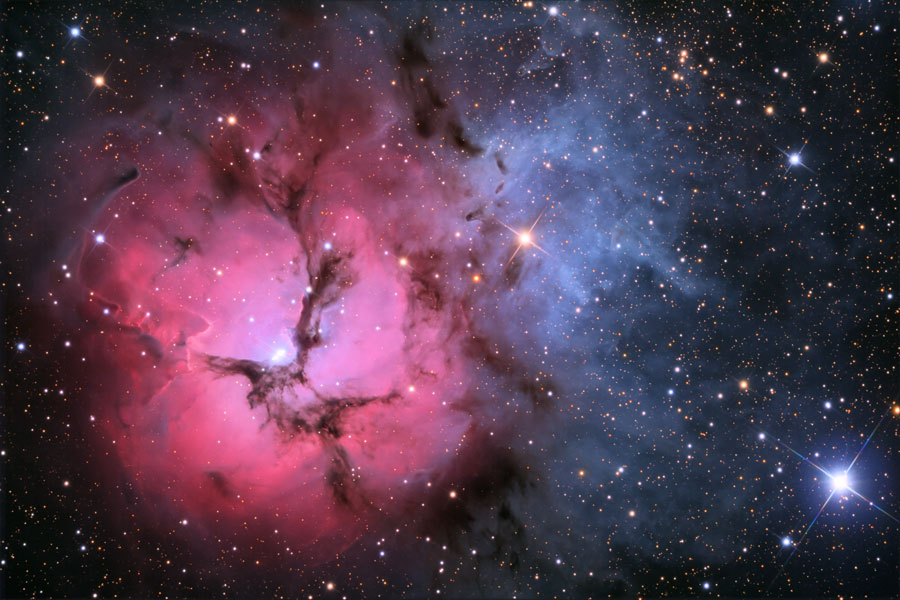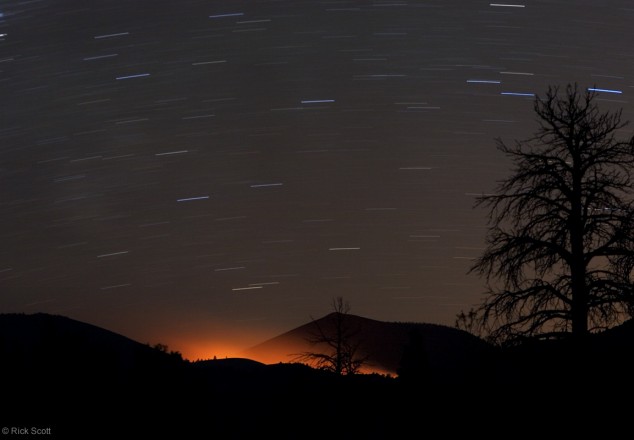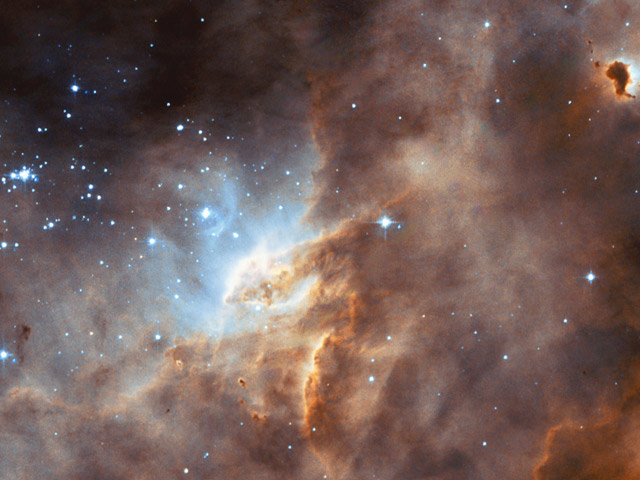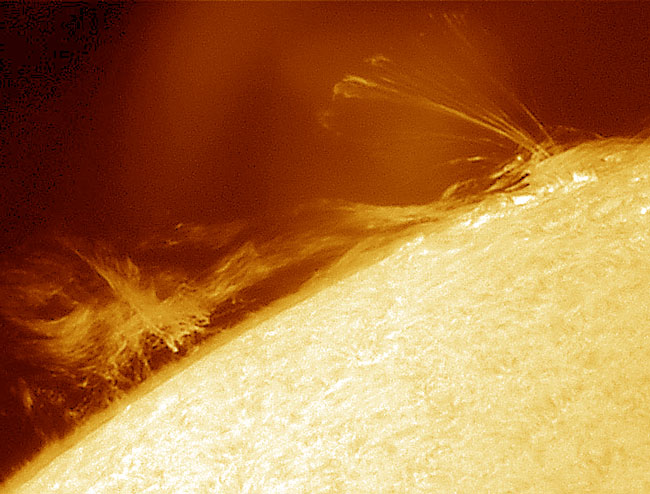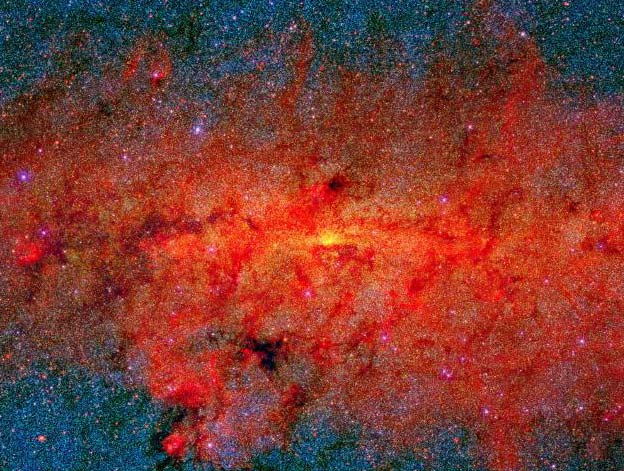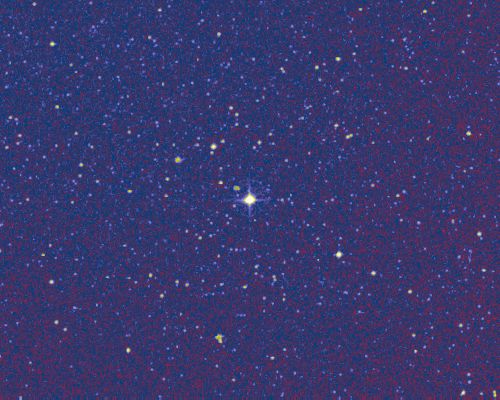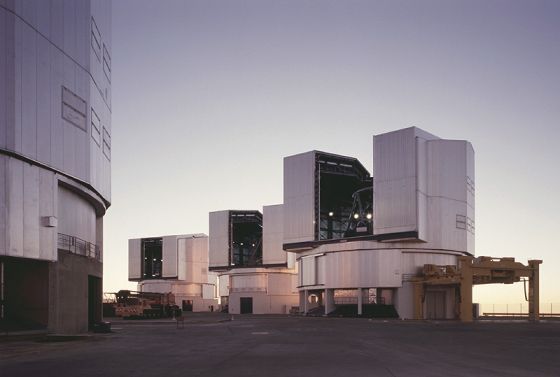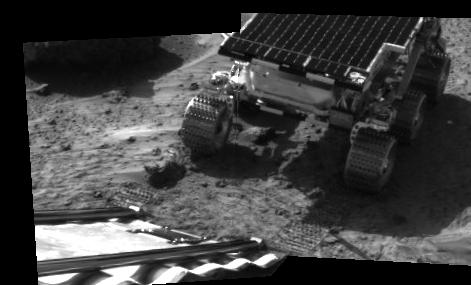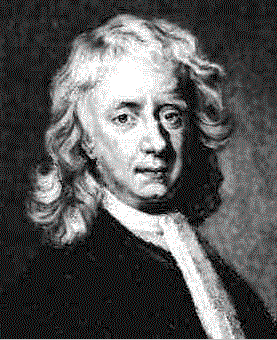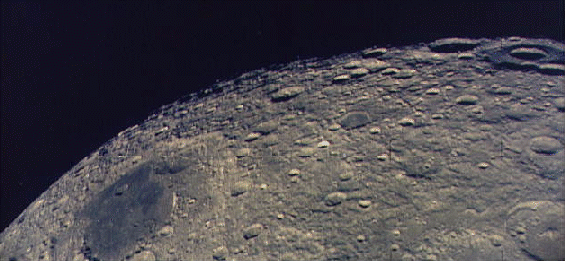| << Previous | Index | Next >> |
2015 What’s happening outside this cave? Nothing unexpected – it’s just the central band of our Milky Way Galaxy passing by. As the Earth turns, the band of our Galaxy appears to rotate and shift along the horizon. The featured image was taken by a photographer who professes a passion for locating sea caves, and who found this spectacular grotto in Leo Carrillo State Park near Malibu, California, USA. After some planning, he timed this single shot image through the 10-meter high cave entrance to show the Milky Way far in the distance. In the foreground, several rocks about one meter across are visible. Visible in the background starscape are millions of stars including the relatively bright and orange Antares, situated just to the right of the image center.
2014 Most galaxies contain one supermassive black hole -- why does this galaxy have three? The likely reason is that galaxy J1502+1115 is the product of the recent coalescence of three smaller galaxies. The two closest black holes are shown above resolved in radio waves by large coordinated array of antennas spread out over Europe, Asia, and Africa. These two supermassive black holes imaged are separated by about 500 light years and each has a likely mass about 100 million times the mass of our Sun. Currently, J1502+1115, at a redshift of 0.39, is one of only a few triple black hole system known and is being studied to learn more about galaxy and supermassive black hole interaction rates during the middle ages of our universe. Gravitational radiation emitted by such massive black hole systems may be detectable by future observatories.
2013 In this beautiful celestial still life composed with a cosmic brush, dusty nebula NGC 2170 shines at the upper left. Reflecting the light of nearby hot stars, NGC 2170 is joined by other bluish reflection nebulae, a compact red emission region, and streamers of obscuring dust against a backdrop of stars. Like the common household items still life painters often choose for their subjects, the clouds of gas, dust, and hot stars pictured here are also commonly found in this setting - a massive, star-forming molecular cloud in the constellation of the Unicorn (Monoceros). The giant molecular cloud, Mon R2, is impressively close, estimated to be only 2,400 light-years or so away. At that distance, this canvas would be about 15 light-years across.
2012 How would you change the course of an Earth-threatening asteroid? One idea - a massive spacecraft that uses gravity as a towline - is illustrated in this dramatic artist's view of a gravitational tractor in action. In the hypothetical scenario worked out in 2005 by Edward Lu and Stanley Love at NASA's Johnson Space Center, a 20 ton nuclear-electric spacecraft tows a 200 meter diameter asteroid by simply hovering near the asteroid. The spacecraft's ion drive thrusters are canted away from the surface. The steady thrust would gradually and predictably alter the course of the tug and asteroid, coupled by their mutual gravitational attraction. While it sounds like the stuff of science fiction, ion drives do power existing spacecraft and a gravitational tractor would work regardless of the asteroid's structure or surface properties.
2011 Peculiar spiral galaxy Arp 78 is found within the boundaries of the head strong constellation Aries, some 100 million light-years beyond the stars and nebulae of our Milky Way galaxy. Also known as NGC 772, the island universe is over 100 thousand light-years across and sports a single prominent outer spiral arm in this detailed cosmic portrait. Its brightest companion galaxy, compact NGC 770, is toward the upper right of the larger spiral. NGC 770's fuzzy, elliptical appearance contrasts nicely with a spiky foreground Milky Way star in matching yellowish hues. Tracking along sweeping dust lanes and lined with young blue star clusters, Arp 78's large spiral arm is likely due to gravitational tidal interactions. Faint streams of material seem to connect Arp 78 with its nearby companion galaxies.
2010 What will passenger airplanes be like in the future? To help brain storm desirable and workable attributes, NASA sponsors design competitions. Shown here is an artist's depiction of a concept plane that has been recently suggested. This futuristic plane would be expected to achieve supersonic speeds, possibly surpassing the speeds of the supersonic transport planes that ran commercially in the late twentieth century. In terms of noise reduction, the future aircraft has been drawn featuring an inverted V wing stretched over its engines. The structure is intended to reduce the sound from annoying sonic booms. Additionally, future airplanes would aim to have relatively little impact on our environment, including green limits on pollution and fuel consumption. Aircraft utilizing similar design concepts might well become operational by the 2030s.
2009 Unspeakable beauty and unimaginable bedlam can be found together in the Trifid Nebula. Also known as M20, this photogenic nebula is visible with good binoculars towards the constellation of Sagittarius. The energetic processes of star formation create not only the colors but the chaos. The red-glowing gas results from high-energy starlight striking interstellar hydrogen gas. The dark dust filaments that lace M20 were created in the atmospheres of cool giant stars and in the debris from supernovae explosions. Which bright young stars light up the blue reflection nebula is still being investigated. The light from M20 we see today left perhaps 3,000 years ago, although the exact distance remains unknown. Light takes about 50 years to cross M20.
2008 This breathtaking patch of sky would be above you were you to stand at the South Pole of the Earth. On the upper left of this image are the four stars that mark the boundaries of the famous Southern Cross. At the top of this constellation, also known as The Crux, is the orange star Gamma Crucis. The band of stars, dust, and gas crossing the middle of the photograph is part our Milky Way Galaxy. Just below the Southern Cross on the far left is the dark Coal Sack Nebula, and the bright nebula on the far right is the Carina Nebula. The Southern Cross is such a famous constellation that it is depicted on the national flag of Australia.
2007 The Trifid Nebula, aka Messier 20, is easy to find with a small telescope, a well known stop in the nebula rich constellation Sagittarius. But where visible light pictures show the nebula divided into three parts by dark, obscuring dust lanes, this penetrating infrared image reveals filaments of glowing dust clouds and newborn stars. The spectacular false-color view is courtesy of the Spitzer Space Telescope. Astronomers have used the Spitzer infrared image data to count newborn and embryonic stars which otherwise can lie hidden in the natal dust and gas clouds of this intriguing stellar nursery. As seen here, the Trifid is about 30 light-years across and lies only 5,500 light-years away.
2006 Big and beautiful spiral galaxy M81 lies in the northern constellation Ursa Major. One of the brightest galaxies in planet Earth's sky, M81 is also home to the second brightest supernova seen in modern times. This superbly detailed view reveals M81's bright yellow nucleus, blue spiral arms, and sweeping cosmic dust lanes with a scale comparable to the Milky Way. Hinting at a disorderly past, a remarkable dust lane actually runs straight through the disk, below and right of the galactic center, contrary to M81's other prominent spiral features. The errant dust lane may be the lingering result of a close encounter between M81 and its smaller companion galaxy, M82. Scrutiny of variable stars in M81 (aka NGC 3031) has yielded one of the best determined distances for an external galaxy -- 11.8 million light-years.
2005 Stars gracefully arc over the glow from a not too distant forest fire in this dramatic time exposure. A recent camping trip with family and friends to Sunset Crater Volcano National Monument, near Flagstaff, Arizona, USA produced the opportunity to record the subtle lighting from Earth and sky. Pointed south with the shutter held open for five minutes, camera and tripod were fixed to planet Earth, producing the gently curving, concentric star trails - a reflection of the planet's daily rotation about its axis. Rising beyond the forest fire's glow is the slope of Sunset Crater, a cinder cone produced by volcanic eruptions some 900 years ago.
2004 Massive stars, abrasive winds, mountains of dust, and energetic light sculpt one of the largest and most picturesque regions of star formation in the Local Group of Galaxies. Known as N11, the region is visible on the upper right of many images of its home galaxy, the Milky Way neighbor known as the Large Magellanic Clouds (LMC). The above image actually highlights N11B, part of the nebula that spans about 100 light years and is particularly active. The entire emission nebula N11 is second in LMC size only to 30 Doradus. Studying the stars in N11B has shown that it actually houses three successive generations of star formation. Compact globules of dark dust housing emerging young stars are also visible on the upper right.
2003 Dramatic prominences can sometimes be seen looming just beyond the edge of the sun. A solar prominence is a cloud of solar gas held just above the surface by the Sun's magnetic field. The Earth would easily fit below the prominence on the left. A quiescent prominence typically lasts about a month, and may erupt in a Coronal Mass Ejection (CME) expelling hot gas into the Solar System. Although very hot, prominences typically appear dark when viewed against the Sun, since they are slightly cooler than the surface. The above image in false color was taken on June 1 from Stuttgart, Germany with an amateur telescope and camera.
2002 The center of our Galaxy is obscured in visible light by dark dust that rotates with the stars in the Galactic Plane. In this century, however, sensors have been developed that can detect light more red that humans can see - light called infrared. The above picture shows what the Galactic Center looks like in three increasingly red bands of near-infrared light. The picture results from a digital combination of data recently taken by the 2MASS and MSX Galactic surveys. In near-infrared light (shown in blue) the dust is less opaque and many previously shrouded red giant stars become visible. In the mid-infrared (shown in red) the dust itself glows brightly, but allows us a view very close to our tumultuous and mysterious Galactic Center.
2001 The unassuming star centered in this sky view will one day be our next door stellar neighbor. The faint 9th magnitude red dwarf, currently 63 light-years away in the constellation Ophiucus, was recently discovered to be approaching our Solar System. Known in catalogs of nearby stars as Gliese (Gl) 710 it is predicted to come within nearly 1 light-year of the Sun ... about 1.5 million years from now. At that distance this star, presently much too faint to be seen by the naked eye, will blaze at 0.6 magnitude - rivaling the apparent brightness of the mighty red giant Antares. Ultimately Gliese 710 poses no direct collision danger itself although its gravitational influence will likely scatter comets out of the Solar System's reservoir, the Oort cloud, sending some inbound. This future stellar encounter was discovered by researchers Joan Garcia-Sanchez and Robert Preston (JPL), and collaborators while studying stars in the solar neighborhood using data from the Hipparcos Astrometry Satellite. The star field shown is based on the Palomar Digitized Sky Survey and is 1/4 degree wide (about half the diameter of the full moon).
2000 From left to right are the enclosures of Yepun (ye-poon; Sirius), Antu (an-too; Sun), Kueyen (qua-yen; Moon), and Melipal (me-li-pal; Southern Cross), pictured here as night falls at Paranal Observatory in northern Chile. These are the four 8.2 meter wide telescope units of the European Southern Observatory's Very Large Telescope (VLT). ESO astronomers and engineers plan to combine the light of the individual units, achieving an equivalent aperture of 16.4 meters which will, for a while, constitue the biggest telescope on planet Earth. Of course, the individual telescopes also function independently. Antu, Kueyen, and Melipal have already achieved first light with Yepun expected to operate in 2001. The telescope names come from the Mapuche language. They were unanimously chosen based on the winning "name-the-telescopes" essay by 17-year old Jorssy Albanez Castilla from Chuquicamata near the city of Calama.
1999
1998 The bright Lagoon Nebula is home to a diverse array of astronomical objects. Particularly interesting sources include a bright open cluster of stars and several energetic star-forming regions. The general red glow is caused by luminous hydrogen gas, while the dark filaments are caused by absorption by dense lanes of dust. The Lagoon Nebula, also known as M8 and NGC 6523, lies about 5000 light-years away. The Lagoon Nebula can be located with binoculars in the constellation of Sagittarius spanning a region over three times the diameter of a full Moon.
1997 The six wheeled robot rover Mars Sojourner rolled onto the martian surface on July 5th (Sol 2) at about 10:40 PM Pacific Daylight Time. This image confirms that its descent down the lander's rear deployment ramp was successful. Click on the image to download a "movie gif" constructed from 9 images taken by the Sagan Memorial Station's IMP camera which shows the rover rolling down the ramp! The rover moved only a short distance from the ramp and spent the night analyzing the martian soil with its Alpha Proton X-Ray Spectrometer. Its next destination will be a tantalizing rock about 1 foot away that scientists have named "Barnacle Bill". A slow but steady off-road vehicle powered by a 1.9 square foot solar array, the rover can negotiate obstacles tilted at a 45 degree angle and travels at less than half an inch per second or nearly 0.03 miles per hour.
1996 Sir Isaac Newton changed the world. Born in 1643, Newton was only an above-average student. But he went home from Cambridge one summer in 1665, thought a lot about the physical nature of the world, and came back two years later with a revolutionary understanding of mathematics, gravitation, and optics. A Professor of his, upon understanding what Newton had done, resigned his own position at Cambridge so Newton could have it. Newton's calculus provided a new mathematical framework for the rapid solution of whole classes of physical problems. Newton's law of gravitation explained in one simple formula how apples fall and planets move. Newton's insights proved to be so overwhelmingly powerful he was the first scientist ever knighted.
1995 In April of 1970, after an explosion damaged their spacecraft, the Apollo 13 astronauts were forced to abandon their plans to make the third manned lunar landing. Still, while coasting around the moon in their desperate attempt to return to earth they were able to photograph the moon's far side. The large, dark, smooth looking feature on the left in this picture is known as the "Mare Moscoviense". It was created by a lava flow filling in a large impact crater on the lunar surface. As suggested by the name, the Mare Moscoviense was first photographed by an early Soviet lunar probe.
| << Previous | Index | Next >> |
